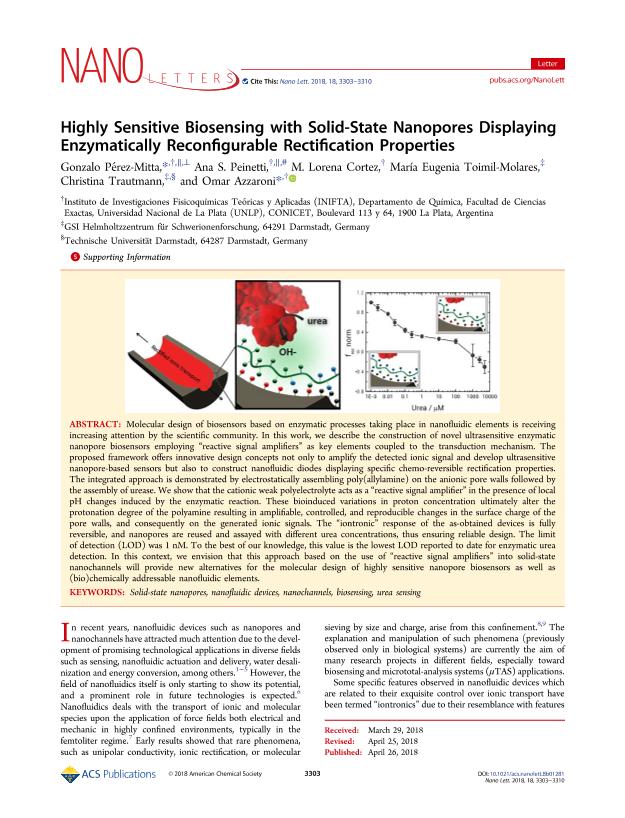Mostrar el registro sencillo del ítem
dc.contributor.author
Perez Mitta, Gonzalo

dc.contributor.author
Peinetti, Ana Sol

dc.contributor.author
Cortez, María Lorena

dc.contributor.author
Toimil Molares, María Eugenia
dc.contributor.author
Trautmann, Christina
dc.contributor.author
Azzaroni, Omar

dc.date.available
2020-03-20T19:39:04Z
dc.date.issued
2018-05
dc.identifier.citation
Perez Mitta, Gonzalo; Peinetti, Ana Sol; Cortez, María Lorena; Toimil Molares, María Eugenia; Trautmann, Christina; et al.; Highly Sensitive Biosensing with Solid-State Nanopores Displaying Enzymatically Reconfigurable Rectification Properties; American Chemical Society; Nano Letters; 18; 5; 5-2018; 3303-3310
dc.identifier.issn
1530-6984
dc.identifier.uri
http://hdl.handle.net/11336/100494
dc.description.abstract
Molecular design of biosensors based on enzymatic processes taking place in nanofluidic elements is receiving increasing attention by the scientific community. In this work, we describe the construction of novel ultrasensitive enzymatic nanopore biosensors employing "reactive signal amplifiers" as key elements coupled to the transduction mechanism. The proposed framework offers innovative design concepts not only to amplify the detected ionic signal and develop ultrasensitive nanopore-based sensors but also to construct nanofluidic diodes displaying specific chemo-reversible rectification properties. The integrated approach is demonstrated by electrostatically assembling poly(allylamine) on the anionic pore walls followed by the assembly of urease. We show that the cationic weak polyelectrolyte acts as a "reactive signal amplifier" in the presence of local pH changes induced by the enzymatic reaction. These bioinduced variations in proton concentration ultimately alter the protonation degree of the polyamine resulting in amplifiable, controlled, and reproducible changes in the surface charge of the pore walls, and consequently on the generated ionic signals. The "iontronic" response of the as-obtained devices is fully reversible, and nanopores are reused and assayed with different urea concentrations, thus ensuring reliable design. The limit of detection (LOD) was 1 nM. To the best of our knowledge, this value is the lowest LOD reported to date for enzymatic urea detection. In this context, we envision that this approach based on the use of "reactive signal amplifiers" into solid-state nanochannels will provide new alternatives for the molecular design of highly sensitive nanopore biosensors as well as (bio)chemically addressable nanofluidic elements.
dc.format
application/pdf
dc.language.iso
eng
dc.publisher
American Chemical Society

dc.rights
info:eu-repo/semantics/openAccess
dc.rights.uri
https://creativecommons.org/licenses/by-nc-sa/2.5/ar/
dc.subject
BIOSENSING
dc.subject
NANOCHANNELS
dc.subject
NANOFLUIDIC DEVICES
dc.subject
SOLID-STATE NANOPORES
dc.subject
UREA SENSING
dc.subject.classification
Físico-Química, Ciencia de los Polímeros, Electroquímica

dc.subject.classification
Ciencias Químicas

dc.subject.classification
CIENCIAS NATURALES Y EXACTAS

dc.title
Highly Sensitive Biosensing with Solid-State Nanopores Displaying Enzymatically Reconfigurable Rectification Properties
dc.type
info:eu-repo/semantics/article
dc.type
info:ar-repo/semantics/artículo
dc.type
info:eu-repo/semantics/publishedVersion
dc.date.updated
2020-03-16T14:01:35Z
dc.journal.volume
18
dc.journal.number
5
dc.journal.pagination
3303-3310
dc.journal.pais
Estados Unidos

dc.journal.ciudad
Washington
dc.description.fil
Fil: Perez Mitta, Gonzalo. Consejo Nacional de Investigaciones Científicas y Técnicas. Centro Científico Tecnológico Conicet - La Plata. Instituto de Investigaciones Fisicoquímicas Teóricas y Aplicadas. Universidad Nacional de La Plata. Facultad de Ciencias Exactas. Instituto de Investigaciones Fisicoquímicas Teóricas y Aplicadas; Argentina
dc.description.fil
Fil: Peinetti, Ana Sol. Consejo Nacional de Investigaciones Científicas y Técnicas. Centro Científico Tecnológico Conicet - La Plata. Instituto de Investigaciones Fisicoquímicas Teóricas y Aplicadas. Universidad Nacional de La Plata. Facultad de Ciencias Exactas. Instituto de Investigaciones Fisicoquímicas Teóricas y Aplicadas; Argentina
dc.description.fil
Fil: Cortez, María Lorena. Consejo Nacional de Investigaciones Científicas y Técnicas. Centro Científico Tecnológico Conicet - La Plata. Instituto de Investigaciones Fisicoquímicas Teóricas y Aplicadas. Universidad Nacional de La Plata. Facultad de Ciencias Exactas. Instituto de Investigaciones Fisicoquímicas Teóricas y Aplicadas; Argentina
dc.description.fil
Fil: Toimil Molares, María Eugenia. Gsi Helmholtzzentrum Für Schwerionenforschung; Alemania
dc.description.fil
Fil: Trautmann, Christina. Gsi Helmholtzzentrum Für Schwerionenforschung; Alemania
dc.description.fil
Fil: Azzaroni, Omar. Universitat Technische Darmstadt; Alemania
dc.journal.title
Nano Letters

dc.relation.alternativeid
info:eu-repo/semantics/altIdentifier/doi/http://dx.doi.org/10.1021/acs.nanolett.8b01281
dc.relation.alternativeid
info:eu-repo/semantics/altIdentifier/url/https://pubs.acs.org/doi/10.1021/acs.nanolett.8b01281
Archivos asociados
